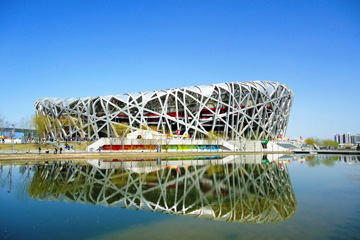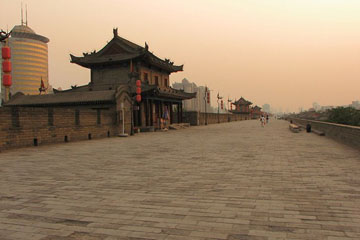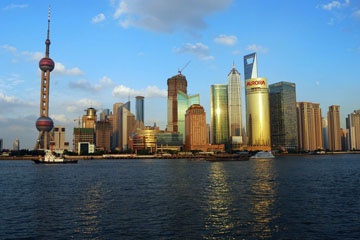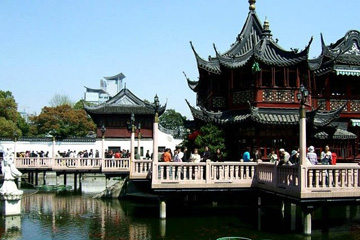
Day 1
BeijingInternational flight on your own arrangement. Once arrive in Beijing,be met and transferred to your hotel. Feel free at leisure for the rest of the day.
Day 2
Beijing-

- The Tian'anmen Square
After breakfast starts with a visit to the Temple of Heaven .You will see local people practicing Tai Chi,as well as singing and calligraphy in the neighboring park,and take a leisurely walk through Tiananmen Square to the Forbidden City, enjoy the panoramic view of Forbidden City form Jing-shan Hill .Then explore the Summer Palace-a former imperial summer resort. Then take the overnight soft sleeper train to Xi'anSample Peking Duck Dinner before a fantastic Kongfu Show .
The Tian'anmen Square : The largest city square in the world.
The Forbidden City : The largest imperial palace in China during the Ming and Qing dynasties with a history of around 600 years.Located in the middle of Beijing, Forbidden City was the Chinese royal palace from the Ming Dynasty to the end of the Qing Dynasty. Also called Palace Museum, the Forbidden City is recognized as the most magnificent and splendid palace complex in China and one of the five world-famous palaces with the Palace of Versailles in France, Buckingham Palace in England, the White House in United States and the Kremlin in Russia.
The Temple of Heaven : Temple of Heaven ( Tiantan ) is located in the southern part of Beijing, and has been one of the most holy places for the whole country for more than five centuries. It used as a complex of sacrificial buildings for the Ming and Qing emperors, and is the largest one in Beijing among several royal altars to Heaven, Earth, the Sun, the Moon and other deities or symbolic forces of Nature.
Summer Place:Situated in the Haidian District northwest of Beijing City, the Summer Palace is 15 kilometers (9.3 miles) from central Beijing. Being the largest and most well-preserved royal park in China, it greatly influences Chinese horticulture and landscape with its famous natural views and cultural interests, which also has long since been recognized as 'The Museum of Royal Gardens' .
Day 3
Beijing-

- Bird Nest National Stadium
Morning head to visit the Great Wall, Ming Tomb .ake a photo stop at the 200 Olympic Site to see the Bird's Nest National Stadium and Water Cube Aquatic Centre Then explore the alleyway -"Hutong" by riding on a traditional rickshaw to catch close-up glimpses of local life. Then take the overnight soft sleeper train to Xi'an.
The Great Wall : One of the seven wonders in the world and the symbol of China.Badaling Great Wall is the most impressive and the most visited section of the Great Wall of China. Constructed in 1502 during the Ming Dynasty, the Badaling Great Wall once served as an important military fortification. Many leaders from China and around the world, like Richard Nixon, Margaret Thatcher…all visited this section of the wall.
The Ming Tomb : The only underground tomb of the thirteen tombs of the emperors in the Ming Dynasty.Some 50 kilometers northwest of the downtown Beijing, the Ming Tombs are generally combined with a visit to the Great Wall. Otherwise known as the “13 Tombs”, this is the burial site of 13 out of 17 emperors of the Ming Dynasty. However, the only one you can get a good look at is the tomb of Emperor Wanli, who reigned from 1537 to 1620. This tomb was unearthed in 1956. There are two others that have been uncovered, but the rest remain illusive.
Bird's Nest National Stadium:The National Stadium, affectionately known as Bird's Nest, is situated in Olympic Green Village, Chaoyang District, Beijing. It was designed as the main stadium of 2008 Beijing Olympic Games. The Olympic events of track and field, football, gavelock, weight throw and discus were held there. Since October, 2008, after the Olympics ended, the National Stadium has been opened as a tourist attraction.
Water Cube Aquatic Centre:Located on the west side of Landscape Avenue in the Olympic Green and to the west of Beijing National Stadium(Bird's Nest), the National Aquatics Center contains the official 2008 Olympics swimming facility. It measures 177 meters (194 yards) long, 177meters wide, and 30 meters (98 feet) high and covers an area of 62,950 sq meters .
Day 4
Xi'an-

- The Ancient City-Wall
Morning arrive Xi'an,you will be met and transferred to your hotel.This afternoon stroll on the original City Wall,Which you have opportunity to cycle on this ancient wall,and then explore the Old Muslim Quarter and Old Mosque.Tonight enjoy a local specialty-dumpling dinner before the famous Tang Dynasty culture show.
The Ancient City Wall : An extension of the old Tang Dynasty structure boasting the most complete city wall that survives through Chinese long history.The City Wall has corner towers, ramparts, sentry towers, gate towers, battlements and a a number of city defensive fortifications with very strong defense capability.
Old Muslim Quarter and Old Mosque:The Great Mosque is a Chinese traditional Alhambresque architecture with a long history and grant scale, which is the great combination of Islamic and Chinese culture. It was recorded that it was established in the first year of the Tian Bao reign by Li Lung Ji, after renovations and expansions on several occasions in the Song, Yuan and especially the Ming and Qing Dynasties, it gradually takes on the current performance.
Tang Dynasty culture show:If you prefer a night performance to kill your night time, Tang Dynasty Show is your best choice, which is on the most Xian visitors' top 10 attractions list. The Tang Dynasty Show showcases the costumes, music, and dancing of China's golden age: the Tang dynasty (618 - 907). The show begins with an ancient Chinese musical instrument ensemble while you dine and then later the cultural dance segment begins. The costumes are splendid and you can get some really nice photos if you sit near the stage.
Day 5
Xi'an-

- The Terra-cotta Warriors and Horses
After breakfast visit the historical significance of the amazing The Terra-cotta Warriors and Horses -where7000 individually crafted clay soldiers stand on guard.Then continue to the Bid Wild Goose Pagoda built to house Buddhist scriptures collected by a Chinese Monk,where you can see variety of buddha statues before taking the express train to the Giant Pandas 'home -Chengdu.
The Terra-cotta Warriors and Horses :The greatest archaeological findings of the century: the army of terra-cotta warriors and the bronze chariots entombed in vast underground vaults at emperor Qin's tomb.
The Wild Goose Pagoda: The pagoda where widely renowned Master Xuanzang (Monk Tripitaka) stored his classics brought from India. Big Goose Pagoda is one of the oldest structures in China. Originally Big Goose Pagoda consisted of a brick structure of five stores and was about 60 meters high. First built in 589A.D.in the Sui Dynasty. Between AD 701 and AD 704 during the reign of the Empress Wu Zetian five more stores were added to the pagoda making ten in all.
Day 6
Chengdu-

- Lesley in Leshan Giant Buddha
Today you will have the opportunity to Enjoy take a sceneic drive to the world's largest Buddha Statue (71ms high) at Leshan County, walk down to the foot of the Buddha and hope on a river cruise
to appreciate its fill stature and splendor from the river.Tonight sample a local speciality-Hot Pot dinner.
Leshan Buddha Sculpture: The Giant Buddha of Leshan (aka dafo) is the tallest stone buddha statue in the world,caved our of a cliff face by an 8th-centry Monk in Southern Szechuan Province.
The Giant Buddha overlooks the confluence of the Minjiang, Dadu and Qingyi Rivers and faces the sacred Mount Emei (with which it shares its Wolrd Heritage Status)
Day 7
Chengdu-

- Giant Panda Breeding and Research Centre
After breakfast visit the fascinating Giant Panda Breeding and Research Centre to learn morn about these amazing endangered animals and the programs that are being implemented to protect them.Enjoy your time to closely watch adorable Pandas playing,eating,climbing and interact.In the afternoon explore the local delights,local market and bustling teahouse.
Giant Panda Breeding and Research Centre:Zoos, scientific research centers, breeding centers, or semi-protected areas work together to maintain a self-sustaining population of a given species. This population may serve as a hedge against extinction of the species, as well as a reservoir for improved understanding of its natural history. The Chengdu Panda Base is an example of a scientific institute engaged in research towards conservation. Our goal is not only to provide technical support for scientific research on wild pandas, but also to increase the wild population through improved management and, ultimately reintroduction of individuals into areas from which the populations have declined. Research at the Chengdu Panda Base focuses on the advancement of wildlife conservation in China.
Day 8
Chengdu-

- Bund
After breakfast flying to Shanghai.Stroll the historic riverfront Bund,where you can see 52 magnificent colonial buildings and the contrasting view of "Old and Modern"Shanghai along the Huangpu River,Then take an under river cable car from Bund to Pudong new areas,reach the top of Jin Mao Building,one of the world's tallest building to enjoy a panoramic view of Shanghai.
Bund: This symbol of Shanghai is known worldwide as the ‘gallery of international architecture.’ Its assortment of buildings standing along the Huangpu River varying in height, color and architectural design make it one of the most magnificent skylines in the world.The Bund is Shanghai's most characteristic landscape. Over one hundred years, it has emerged as a symbol of Shanghai. It is located between the Nanpu Bridge and the Waibaidu Bridge in the West Bank of Huangpu River, with the total length of four kilometers. It is one of the new ten landscapes of the Shanghai 90s and the top ten tourist attractions. The Huangpu River, Long Beach, Green Square, as well as magnificent architectural complex together constitute a spectacular Shanghai incomparable landscape.
Huangpu River:Huangpu River is a branch of the lower reaches of theYangtze River. It lies in Shanghai City, formerly known as Huangxiepu or Chunshen River. It takes its rise from theTai Lake, runs eastwards through the Dianshan Lake in Qingpu County and then flows to Minhang District in Shanghai. At the Baidu Bridge in the center of Shanghai City, Huangpu River flows together with the Wusong River (i.e. Suzhou River) and finally flows into the East China Sea.
Day 9
Shanghai-

- Yuyuan Gardens
In the morning you will visit Yuyuan Garden and Jade Budda Temple, Travel to the ancient water town of Zhujiajiao to see the old residences built during Ming and Qing Dynasties,explore twisting cobble streets and distinctive bridges.and then stop at the contrasting,modern Xintiandi,a restored area of old residential house .Followed by a visit to the superb Shanghai Museum.
Yuyuan Gardens: A famous garden of beauty and tranquility in the heart of Shanghai built during the Ming Dynasty 400 years ago as a son’s gift to his parents.Black tiles and white walls establish a nonchalant and simple keynote . The dainty style makes one feel comfortable, and each exquisite window lattice is telling its own story, serves the record of the past delicate life. Every piece of roof tile is passing a sort of affection of pride and memories.The entire Yuyuan Garden is bordered by the Dragon Wall.
Jade Buddha Temple:A beautiful Buddhist temple constructed in 1882 housing two spectacular, imported, jade, Burmese Buddhas.
Zhujiajiao: Zhujiajiao is a township in the Qingpu District of Shanghai. The Qingpu District has a lake and is being developed as a tourist resort area. Zhujiajiao is a township in the Qingpu District of Shanghai. The Zhujianjiao Ancient Town has a population of about 70,000 people. In the centuries past, because of many canals, it was a trading area. People would ferry products and themselves around in little boats and barges. So there are some buildings that date to the Qing Dynasty era (1644-1912) or the early 1900s. Nowadays, younger people and people with some money but want to relax from work are going there to live. It is an official tourist area, so some attractions and buildings require a ticket that you can buy at the gate to the area. However, just to walk around, you don’t need a ticket. Many old people live there.
Shanghai Museum: Shanghai Museum used to be near the Bund area. It is now situated in People's Square and its new buildings were built in 1996, designed by a Shanghai architect named Xing Tonghe. The new design symbolizes China's ancient understanding of the world: round sky and square earth. The museum has a circular roof and rectangular base. It stores 120,000 precious artifacts, which narrate a story of China's 5,000-year civilization.
Day 10
Depart Shanghai
Airport tranfer based on your flight info.end of services.
| Travel in party of |
Superior Class ★★★★★ |
Deluxe Class ★★★★ |
Tourist Class ★★★ |
| 2-4 persons | $ | $ | $ |
| 5-9 persons | $ | $ | $ |
| 10 persons & above | $ | $ | $ |
| Single room Supplement | $ | $ | $ |
Service included:
√ Excellent English guide service
√ All the entrance fee listed in the itinerary
√ 4star Hotels listed in the itinerary with breakfast,
√ Two bottles of water each person every day
√ 2nd class express train listed Xi’an to Chengdu
√ 1st class overnight train listed, Beijing to Xi’an
√ Airfare from Chengdu to Shanghai.
√ Visa support letter if necessary
Service excluded:
× Personal expenses and tips to the guide and driver
× International airfare with tax
× No guide service if only airport and train transfer only.






